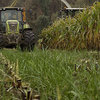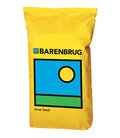As Maize harvest progresses in the UK, thoughts turn to post maize and post cereal field management. Maize harvests, particularly in the north or in times of very inclement weather, can be very late in the year leaving little opportunity to establish another crop.
As is widespread, a major problem with a late harvest seasons are that bare fields are at a much higher risk of soil erosion and nutrient leaching, with rainwater run-off also taking topsoil and nutrients away with it which can often ends up in drains and watercourses. As land managers, it is best practise to mitigate and reduce the risk of this wherever possible. It is our belief that the requirement within agriculture to reduce environmental pollution and soil degradation will only get more prevalent and carbon capture, or mitigating carbon losses, will also become a criterion.
Grass can be a very useful crop to follow maize or cereals later in the year because of its flexibility. Grass swards can simply provide a catch crop for soil stability and mopping up nutrients, an overwintering feed source for any class of sheep or an early silage crop in the following spring.
Dependant on the region of the UK, some environmental schemes exist where payments are available to growers establishing post maize or cereal crops and managing them as set out with the guidance on the individual scheme. Contact your local agricultural advisor for schemes relevant to your enterprise and location.
What could I establish?
Aftermaize is our dedicated post-maize product. The mixture contains 50% Italian ryegrass as well as hybrid ryegrass and a small percentage of perennial ryegrass. Ideally, this mixture should be established before soils are below 7OC to allow best establishment of the perennial ryegrasses. Aftermaize will provide a short-term grass break crop of up to 2 years for silage production with the option to graze in the autumn and winter.
Italian Ryegrasses are an excellent option for later sowing as they germinate down to 4OC soil temperature, lower than perennial grass species and legumes, meaning you have an increased chance of success of a good establishment later in the season. They will establish quickly under good soil and environmental conditions.
Short term grass is flexible enough to simply plough in after a few months, graze, cut for silage or zero grazing. Italian ryegrasses will give up to 20% more yield than perennial ryegrasses. After ploughing in, Italian ryegrass will steadily release the nitrates it has mopped up from the soil, back to the subsequent crop.
Barenbrug’s High D Italian is a mixture of Italian rye grass diploid and tetraploid species, which includes the high ranking Barmultra II. Having a blend of diploids and tetraploids improves the ground cover and tillering capacity of the sward over a straight tetraploid, which improves its performance in all scenarios after a late sowing. High D Italian is supplied in 14kg packs and can produce 20% more grass than perennial ryegrass.
How much should I sow?
The intended use of the sward will influence the sowing rate of whatever grass option you choose. If going for a catch crop to hold soil and capture nutrients or even graze a limited amount of store lambs in autumn, then sowing around 10kg/acre (25kg/ha) would suffice. If there are a lot of sheep to feed throughout the whole winter or the aim is to achieve an early silage cut in spring then sowing at 12.5kg/acre (32kg/ha) is advisable. In the instance of wishing to retain the crop for a full two seasons, or where soil and growing conditions are less favourable, the sowing rate could be increased again to 14kg/acre (35kg/ha) for optimal persistence.







